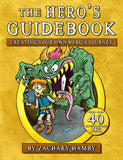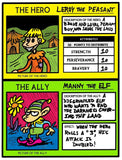Teaching Joseph Campbell's The Hero's Journey

Joseph Campbell, an American mythological researcher, wrote a famous book entitled The Hero with a Thousand Faces. In his lifelong research Campbell discovered many common patterns running through hero myths and stories from around the world. Years of research lead Campbell to discover several basic stages that almost every hero-quest goes through (no matter what culture the myth is a part of). He calls this common structure “the monomyth.” It is commonly referred to as "The Hero's Journey."
George Lucas, the creator of Star Wars, claims that Campbell’s monomyth was the inspiration for his groundbreaking films. Lucas also believes that Star Wars is such a popular saga because it taps into a timeless story-structure which has existed for thousands of years.
The Hero's Journey is a great technique for analyzing all kinds of stories--whether they be myths, legends, films, novels, short stories, plays, or even comic books. Educating students about the Hero's Journey encourages them to think about plot structure, character motivation, and theme. It also leads them to consider what qualities they associate with heroes. Are heroes born or are they made? Are there heroes in real-life or must they be larger-than-life? Who are the heroes in our society. Listed below are some resources that I have found successful in my own classroom for teaching the Hero's Journey:
THE HERO'S JOURNEY (PDF) This worksheet gives an overview of the Hero's Journey, as outlined by Joseph Campbell and others. Each step is listed, along with examples from film and literature.
SAMPLE HERO'S JOURNEY UNIT (PDF) This outline provides a suggested unit using this site's resources.
WHY YOUNG PEOPLE NEED HERO STORIES NOW MORE THAN EVER (ARTICLE) This article explains the numerous real-life applications of the Hero's Journey, a message of hope that young people need to hear!
DETAILED PRESENTATION ON THE STAGES OF THE HERO'S JOURNEY WITH LIFE-APPLICATION (SALE ITEM) This in-depth presentation covers the stages of the Hero's Journey, using visual examples from Star Wars and The Lion King. Each stage also has a "My Journey" section that gives each stage a real-life application. Also comes with a note-taking sheet with student use.
DESIGN-A-QUEST: CREATIVE GRAPHIC ORGANIZERS FOR MAKING YOUR OWN HERO'S JOURNEY (SALE ITEM) Want to give your students some practice writing their own Hero's Journey? This set of graphic organizers is perfect for young writers who want to invent some heroes of their own. Using your choice of written-response only or a creative, comic-book-style combination of artwork and written responses, these graphic organizers allow students to create their own hero story. This item also includes a sample Hero's Journey using Disney's Aladdin as an example.
This PDF identifies the stages of the Hero's Journey present in the 1993 film The Lion King. Although almost all the stages are present, they do not go in a progressive order (as the stages in Star Wars do).
This worksheet gives an overview of the various types of heroes: mythic heroes, anti-heroes, tragic heroes, Byronic, heroes, etc. It also analyzes famous anti-heroes from pop culture and literature.

 This classroom game, based on concepts from the Hero's Journey by Joseph Campbell, asks students to create their own hero quest. In groups of two, students will create an original hero quest and then play it out. Click the link above for more details.
This classroom game, based on concepts from the Hero's Journey by Joseph Campbell, asks students to create their own hero quest. In groups of two, students will create an original hero quest and then play it out. Click the link above for more details.This article recounts the accomplishments of actor Christopher Reeve, including his heroic struggle with paralysis. Using this article as a springboard, students can compare Superman, the character embodied by Reeve, and the actor's real-life heroic struggle.
This fan-created music video uses the song "Holding Out for a Hero" by Bonnie Tyler and images from popular superhero movies, as well as Saturday morning cartoons. (Appropriate for classroom use.)
This assignment asks students to analyze a comic book, looking for the heroic characteristics applied to a certain superhero. They must decide who considers their subject a hero, what makes him or her a hero, and also draw a picture of the character. (Requires classroom set of comic books.)
This personal essay by Oliver Stone examines the concept of a hero. What makes a person heroic? Can this definition change over time? This is a great springboard for student conversation.
 THE WRITER'S JOURNEY BY CHRIS VOLGER (BOOK ON AMAZON.COM) This informative guide to The Hero's Journey, written by a Hollywood script writer, is informative and insightful. I recommend it for anyone who wants a deeper look at the Hero's Journey. Read more or buy this book on Amazon.com.
THE WRITER'S JOURNEY BY CHRIS VOLGER (BOOK ON AMAZON.COM) This informative guide to The Hero's Journey, written by a Hollywood script writer, is informative and insightful. I recommend it for anyone who wants a deeper look at the Hero's Journey. Read more or buy this book on Amazon.com.
